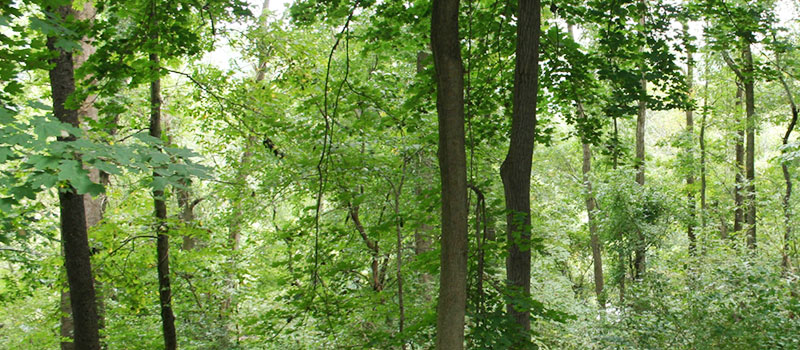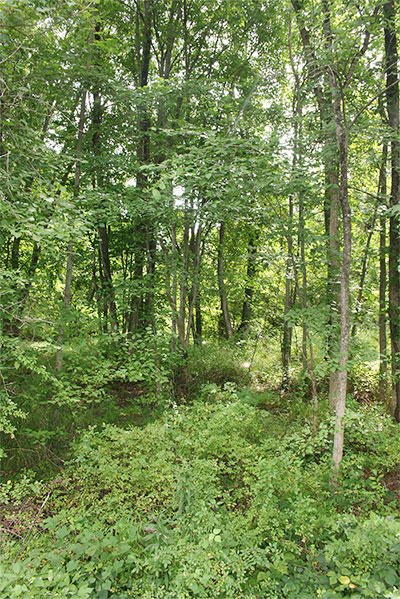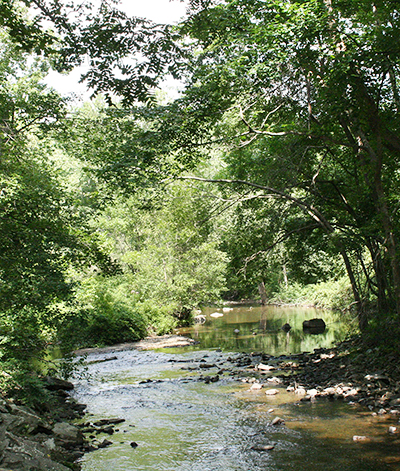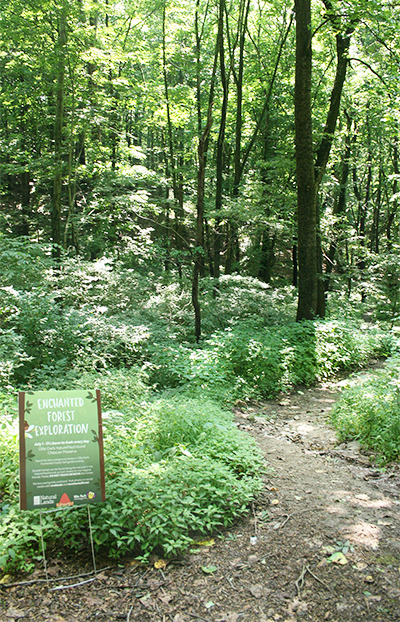In 2015, approximately 26% of the county was wooded, compared to nearly 30% in 1995.
How it Works
The information contained in this eTool applies to conserving woodlands as defined in the land development process. This may include identification of woodlands and investigating means to minimize and mitigate impacts to woodlands as part of the land development process. Woodlands conservation does not apply to timber harvesting, as this is an agricultural use covered by the Pennsylvania ACRE law.
Woodlands occur throughout the county and are a critical natural resource in the region. Protecting woodlands provides significant and wide-ranging benefits. Trees and woodlands provide shade, capture stormwater runoff, filter pollutants, mitigate urban heat islands, remove carbon from the atmosphere, and provide wildlife habitat. Land management and zoning tools such as "netting out" a portion of the woodlands from lot area and density calculations and regulating the disturbance of woodlands can be incorporated into local zoning and subdivision and land development ordinances.
Like many other natural resources, woodlands are impacted by development pressures from residential and nonresidential expansion. Woodlands also face threats from invasive insect and plant species and a warming climate. In 2015, approximately 26% of the county was wooded, compared to nearly 30% in 1995. This eTool describes techniques local municipalities can use to preserve, maintain, and restore woodlands during the land
Benefits
Minimization of stormwater runoff and erosion
Woodlands function as natural stormwater management facilities and help to minimize stormwater runoff and soil erosion. The diverse vegetation of woodlands helps to reduce runoff in a number of ways: leafy tree canopies reduce potential erosion from storm events, while natural areas and roots of vegetation promote infiltration and provide areas for stormwater to evaporate. These stormwater management benefits result in a reduction of soil erosion, whether in agricultural, residential, or urbanized areas.
Climate change mitigation
Protection of trees and woodlands helps to minimize and mitigate climate change, provide cooling effects in urban areas, and provide shade and wind protection for homes and businesses. Woodland protection also protects water and air quality by providing stormwater management, and reducing airborne pollutants through tree canopies.
Economic value
As documented in the Return on Environment study, protected natural areas provide great economic value to Chester County through reduced costs for stormwater management infrastructure, water quality protection, flood mitigation, recreational and health benefits, and higher property values.
Natural habitat preservation
Woodlands provide habitat to a wide variety of plant and animal species including threatened and endangered specifies. Woodlands greater than twenty-five acres can provide contiguous habitat for animals sensitive to fragmenting features such as highways, active railroads, and utility rights-of-way.
Energy Conservation
Swaths of woodland reduce the urban heat island effect, help to filter pollutants from the air, and reduce stormwater runoff and erosion. This helps to reduce energy demands associated with cooling needs and additional built stormwater infrastructure.
Recreational opportunities
Many desirable recreational opportunities occur in natural and preserved areas containing woodlands. Preserved woodlands offer recreation opportunities for multipurpose trails, which support activities such as hiking, biking, and walking.
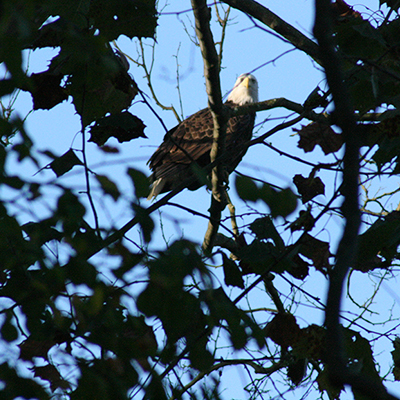
Woodlands provide habitat to a wide variety of plant and animal species, including threatened and endangered species.

Preserved woodlands offer recreation trail opportunities.
Municipalities should have an inventory of woodlands to understand their coverage and quality and to plan for conservation.
Get Started
There are a variety of ways to preserve and protect woodlands during the land development process. Municipalities can manage woodlands through both non-regulatory and regulatory processes. Active planning and involvement by the local municipal government can be very effective in conserving this critical component of the natural environment.
Establish Policy
Municipal comprehensive planning, including open space and recreation planning, is the most direct process for establishing municipal conservation policy efforts. These plans can contain maps, inventories and descriptions of the woodland classification in a municipality, as well as goals and objectives for their conservation.
Resource Inventory
Woodlands can be inventoried in a municipality's comprehensive plan, a stand-alone environmental resources plan, as part of an open space plan, or as an individual study. Woodlands should be inventoried and mapped as an individual map and/or coverage in Geographic Information System (GIS) to provide a general idea of the location and extent of woodlands. As part of the woodlands survey, municipalities may want to complete a forest stand delineation to classify the quality of woodlands present, which may guide preservation priorities.
Non-regulatory Techniques
Non-regulatory techniques for protecting woodlands may include providing incentives or the encouragement of developer dedicated easements during the land development process, as well as incentivizing individual property owner easements. Municipalities should consider the strategic acquisition of land for woodland conservation based on their policy plans for preservation. Other techniques include the restoration and replanting of woodlands. Non-profits and agencies such as TreeVitalize and the USDA provide support and advocate for tree planting to increase woodland coverage.
Regulatory Techniques
Municipalities can provide for the health, safety and welfare of their communities by regulating land use activities to preserve and protect woodlands and other critical resources.
Develop and Adopt Ordinance Standards: After a policy basis is established, a municipality should amend its zoning ordinance to include woodland protection standards and maximum disturbance limits as related to land development. The subdivision and land development ordinance should require site specific identification of woodlands to be conducted as part of the land development process. Strategies may include provisions being added to the preliminary and final plan requirements of the subdivision and land development ordinance to require such studies. Incentives for land use applicants may be developed which reward the preservation of woodland areas.
The following are regulations that municipalities should implement to best protect woodlands:
- Apply a maximum disturbance of 50%, but consider even less disturbance (e.g., 35%) for residential development
- Protect trees that will remain on site during construction through a tree protection zone
- Consider including special provisions for the protection of specimen trees (i.e., trees above a specified diameter and/or determined to be of specimen quality as defined in the ordinance)
- Consider requiring replacement of trees that are removed.
- Woodlands protection does not apply to timber harvesting, which is dealt with as a separate agricultural use subject to the ACRE legislation. Additional information on ACRE is provided by the Pennsylvania Attorney General's ACRE — Agriculture, Communities and Rural Environment and the CCPC's ACRE Info Sheet.
Regulations of associated or overlapping natural resources can also help protect woodlands. Additionally, identification of specific areas included on the Chester County Natural Heritage Inventory (CCNHI) can help protect natural habitats and woodlands.
Zoning Considerations: Zoning ordinances can protect woodlands in a number of ways. Beyond the natural resource protection standards listed above, municipalities can implement zoning to set development patterns that further encourage natural resource protection. For example, cluster zoning or Transfer of Development Rights (TDR) are suggested methods of protecting woodlands by directing growth toward land most suitable to be developed while preserving areas of land containing high value natural resources within the protected open space.
Review Established Standards
Some woodlands may be at least partially protected through existing local ordinance standards. For existing woodland protection standards, a full review of the ordinance should be undertaken to determine the best approach for updating or expanding the resource protection standards to address modern environmental best practices. Depending on the strength of the current standards, amendments to fill in the gaps and add more specific protection criteria may be all that is required. Otherwise, a full update and reorganization of the protection standards may be needed.
Natural Features Ordinance Organization
A well-organized ordinance makes it easier to apply and enforce the provisions, avoid inconsistencies, and provide a clearer understanding of resource protection requirements for municipal officials, landowners, and developers. The most efficient means of organizing natural resource standards in municipal regulations is to include an umbrella approach to natural resources addressing woodlands as well as wetlands, steep slopes, and riparian buffers in a single article of the ordinance. The woodland protection standards should be clearly defined and placed in one location in the ordinance, rather than several different sections.
Municipalities should regularly monitor the health of conserved woodlands and the need for maintenance.
Considerations
Clearly define ordinance standards
For natural resource regulations to be effective, specific regulations and land development policies need to be defined. For example, a clear definition for woodlands to be delineated in the land development process should be determined. Language should be definitive in establishing maximum disturbance limits for woodlands, as well as activities permitted (or permitted by conditional use) within woodlands such as natural surface trails or passive recreation. Additional items to consider may include developing ordinance regulations which clearly differentiate between individual tree removal and the disturbance of woodland swaths.
Woodlands management
Preserved woodlands should be managed to address invasive species and to ensure that disturbance is not occurring within preserved areas. Woodlands offering recreation such as trails may need to be closely monitored by municipalities for recreation upkeep and to monitor the health of woodlands. In the case of eased properties, the preserving organization may require an open space or woodlands management plan as part of the easement agreement.
Encourage contiguous protection
For the most effective protection, woodlands should be protected as contiguously as possible and ideally, protection should extend into neighboring municipalities through the adoption of consistent ordinances. The cooperation and assistance of government agencies, adjacent municipalities, and land trusts may be needed to establish corridors or networks of woodlands.
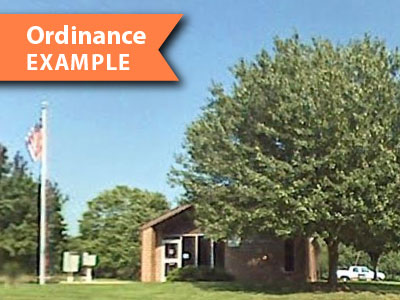
Franklin Township woodland protection standards are located in their zoning ordinance which a maximum woodland disturbance of 35% for residential uses and 50% for nonresidential uses.
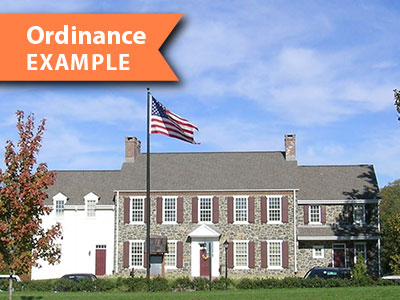
Kennett Township has a number of environmental protection standards, including those applying to woodlands. In the zoning ordinance, woodlands are defined in multiple tiers with various levels of protection. The subdivision and land development ordinance contains standards to protect trees to remain during construction.
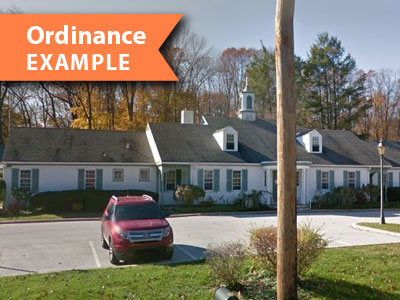
Willistown Township has a number of woodland protection standards in place in the township's environmental protection ordinance. This ordinance has extensive information regarding the delineation of woodlands, and sets maximum disturbance limits for woodlands.
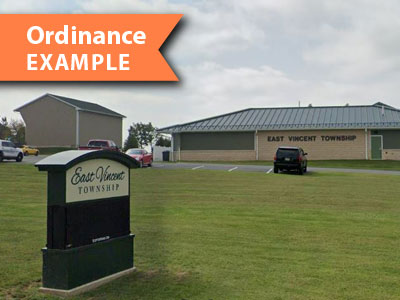
East Vincent Township protects woodlands and large freestanding trees through maximum disturbance limitations located within their subdivision and land development ordinance. The ordinance also includes woodland replacement standards when more than a specified square footage or percentage of woodlands are disturbed
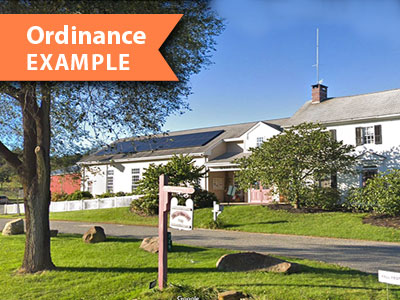
West Vincent Township has comprehensive woodland protection standards in their zoning ordinance, which establishes maximum disturbance limits ranging from 15%-50%, depending on the type and quality of woodland, as well as the type of use (residential or non-residential). The ordinance also contains timber harvesting regulations, and an appendix of recommended best practices for timber harvesting operations.
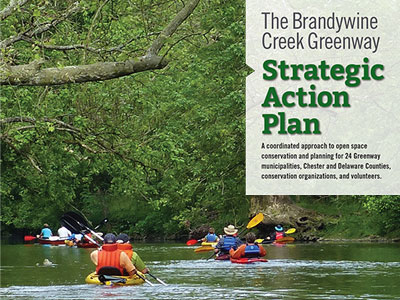
Model Resource Protection Ordinance
The Chester County Planning Commission partnered with the Brandywine Conservancy in 2015 to develop a set of natural resource protection standards to support the Conservancy's Brandywine Creek Greenway initiative. The Natural Resource Protection standards provide a template and background information for addressing natural resource protection through municipal ordinances. The model standards are located in The Brandywine Creek Greenway Strategic Action Plan Part 3 — Toolkit starting on page 327. Specific woodlands standards are located in the same document starting on page 336.
The Schuylkill Township Zoning Ordinance "Conservation of woodlands and other vegetation" section protects woodlands as well as individual specimen trees (trees above a defined size) on private property. The tree removal permit section of the ordinance includes exemptions and allowances for property owners to remove trees if specific criteria are met. Tree replacement is also addressed.


